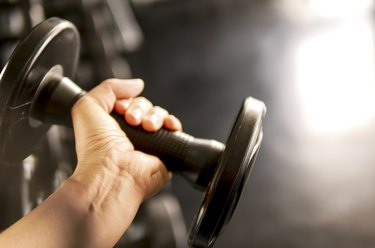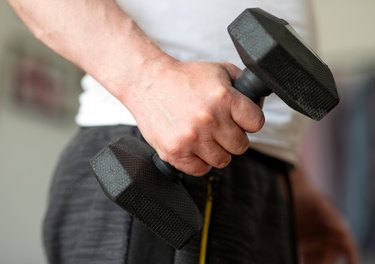
Your forearms may very well be the underrated MVP of your entire body — helping you hold onto grocery bags, dog leashes and barbells that weigh more than you do.
And when it comes to strengthening your forearms and grip, you just can't leave out wrist curls.
Video of the Day
- What is a wrist curl? It's an exercise that involves raising a weight by bending your wrist and drawing your palm toward the inside of your forearm.
- What muscles does it work? It strengthens your wrist flexors, which go from your elbow into your wrist, according to Sam Becourtney, DPT, CSCS, a New York-based physical therapist. These muscles make up most of your inner forearm.
- Who can do this exercise? This move is friendly for all fitness levels. Those who have previous wrist injuries and carpal tunnel can benefit from the move, but they should consult a doctor before giving it a try, he says.
How to Do the Wrist Curl With Perfect Form
Start out with a light dumbbell (less than 10 pounds), performing about 3 sets of 10 to 12 reps, says certified strength and conditioning specialist Sam Chan, DPT, CSCS. As you grow more comfortable, you can try heavier weights.
Wrist Curl
- Kneel next to a workout bench or chair with a dumbbell in one hand.
- Place your elbow and arm on the bench with your forearm and palm facing up. Let your wrist relax and fall away from your forearm with the dumbbell hanging toward the ground.
- Keeping your arm in place, bend your wrist toward your forearm as far as comfortable.
- Pause, then slowly reverse the motion with control.
- Do all reps, then switch sides.
Tip
You can also do a wrist curl with the back of your forearm resting on your thigh. Just make sure to keep your forearm and elbow stationary.
3 Wrist Curl Benefits
1. Stronger Wrist Flexors
Your wrist joint attaches to a group of muscles that run along your entire forearm. Called your wrist flexors, these muscles are the reason you can bend your wrist, fingers and take hold of whatever you need.
Strengthening your wrist flexors improves your grip strength, which may provide an interesting window into your longevity. As you age, a decrease in grip strength may help predict a decline in mobility, mental health and day-to-day function, according to a January 2015 study in Geriatrics and Gerontology International. (While strengthening your grip alone won't lengthen your life, adding it into your routine can certainly help.)
Plus, maintaining a healthy grip is helpful as you age. Plenty of day-to-day activities require grip strength, according to Becourtney. Stronger wrist flexor muscles can help you more easily accomplish these tasks.
2. A Lower Risk of Injury
Spending a lot of your day at a desk can put excess stress on the joints in your hands and wrists, Becourtney says. When you type, your wrists sit in an extended (bent-back) position. This can cause muscle imbalances over time.
Exercises like wrist curls strengthen the muscles on the opposite side of your forearm, helping even out any possible imbalances. In other words, this exercise can help counteract the negative effects of typing at a desk all day, he says.
3. Stronger Lifting
Ever feel your grip falter when you do deadlifts or rows? That's because grip strength is often a limiting factor in big lifts, meaning your forearms, wrists and hands give out before your glutes and lats do.
Improving your forearm and grip strength can help you lift and lower heavier objects with more confidence and safety, Becourtney says.
Try These 4 Wrist Curl Variations
Move 1: Eccentric Wrist Curl
- Kneel next to a workout bench or chair with a dumbbell in one hand.
- Place your elbow and arm on the bench with your forearm and palm facing up. Let your wrist relax and fall away from your forearm with the dumbbell toward the ground.
- Keeping your arm in place, use your free hand to bend your wrist toward your forearm as far as comfortable.
- Without the help of your free hand, slowly lower the weight to the starting position for a three-second count.
- Do all reps, then switch sides.
By slowing down the lowering phase of each rep, you make the exercise more difficult without having to use a heavier weight, Chan says.
Move 2: Reverse Wrist Curl
- Kneel next to a workout bench or chair with a dumbbell in one hand.
- Place your elbow and arm on the bench with your forearm and palm facing down. Let your wrist relax with the dumbbell toward the ground.
- Keeping your arm in place, bend your wrist toward your forearm as far as comfortable.
- Pause, then slowly reverse the motion with control.
- Do all reps, then switch sides.
Flip your grip to strengthen the wrist extensors in the back of your forearm. Training both sides of any joint (like your wrist) helps to support muscle balance.
Move 3: Hammer Wrist Curl
- Kneel next to a workout bench or chair.
- Hold a dumbbell with a neutral grip with your thumb facing up.
- Place your elbow and the outer edge of your forearm on the bench. You want to be resting on the bone that runs from your elbow to your wrist.
- Keeping your arm in place, bend your wrist toward your forearm leading with your thumb.
- Pause, then slowly reverse motion with control.
- Do all reps, then switch sides.
This variation helps strengthen the left and right sides of your wrists, as opposed to the inside and outside, according to Chan. Including this version helps build all-around strength in these joints.
Move 4: Barbell Wrist Curl
- Kneel next to a workout bench.
- With each hand, hold a barbell at about shoulder-width distance.
- Place your elbows and forearms on the bench, forearm facing up.
- Keeping your arms in place, bend your wrists towards your forearms as far as comfortable.
- Pause, then slowly reverse the motion with control.
Tip
Most barbells weigh about 45 pounds, so this is a pretty advanced wrist curl variation. Try a few reps and if you see your elbows start to shift, try a different version of this exercise.
Was this article helpful?
150 Characters Max
0/150
Thank you for sharing!
Thank you for your feedback!



